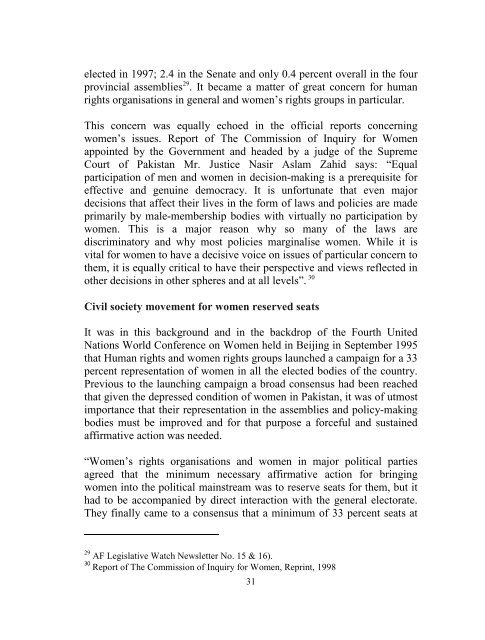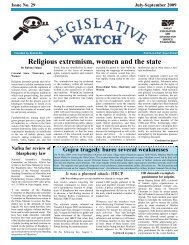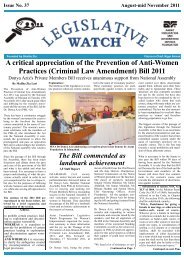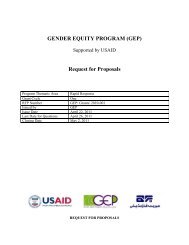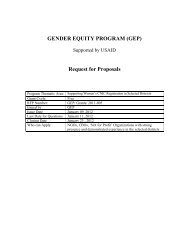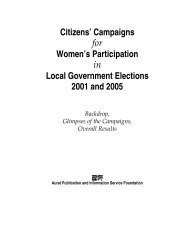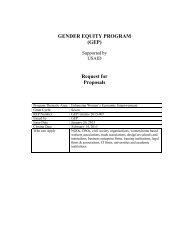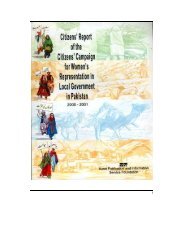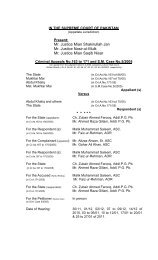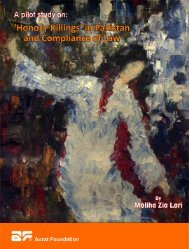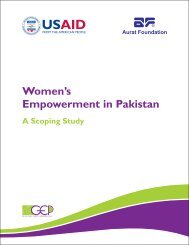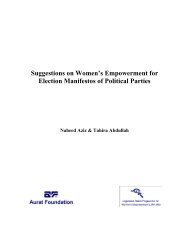Legislative Quotas for Women: A global and ... - Aurat Foundation
Legislative Quotas for Women: A global and ... - Aurat Foundation
Legislative Quotas for Women: A global and ... - Aurat Foundation
- No tags were found...
Create successful ePaper yourself
Turn your PDF publications into a flip-book with our unique Google optimized e-Paper software.
elected in 1997; 2.4 in the Senate <strong>and</strong> only 0.4 percent overall in the fourprovincial assemblies 29 . It became a matter of great concern <strong>for</strong> humanrights organisations in general <strong>and</strong> women’s rights groups in particular.This concern was equally echoed in the official reports concerningwomen’s issues. Report of The Commission of Inquiry <strong>for</strong> <strong>Women</strong>appointed by the Government <strong>and</strong> headed by a judge of the SupremeCourt of Pakistan Mr. Justice Nasir Aslam Zahid says: “Equalparticipation of men <strong>and</strong> women in decision-making is a prerequisite <strong>for</strong>effective <strong>and</strong> genuine democracy. It is un<strong>for</strong>tunate that even majordecisions that affect their lives in the <strong>for</strong>m of laws <strong>and</strong> policies are madeprimarily by male-membership bodies with virtually no participation bywomen. This is a major reason why so many of the laws arediscriminatory <strong>and</strong> why most policies marginalise women. While it isvital <strong>for</strong> women to have a decisive voice on issues of particular concern tothem, it is equally critical to have their perspective <strong>and</strong> views reflected inother decisions in other spheres <strong>and</strong> at all levels”. 30Civil society movement <strong>for</strong> women reserved seatsIt was in this background <strong>and</strong> in the backdrop of the Fourth UnitedNations World Conference on <strong>Women</strong> held in Beijing in September 1995that Human rights <strong>and</strong> women rights groups launched a campaign <strong>for</strong> a 33percent representation of women in all the elected bodies of the country.Previous to the launching campaign a broad consensus had been reachedthat given the depressed condition of women in Pakistan, it was of utmostimportance that their representation in the assemblies <strong>and</strong> policy-makingbodies must be improved <strong>and</strong> <strong>for</strong> that purpose a <strong>for</strong>ceful <strong>and</strong> sustainedaffirmative action was needed.“<strong>Women</strong>’s rights organisations <strong>and</strong> women in major political partiesagreed that the minimum necessary affirmative action <strong>for</strong> bringingwomen into the political mainstream was to reserve seats <strong>for</strong> them, but ithad to be accompanied by direct interaction with the general electorate.They finally came to a consensus that a minimum of 33 percent seats at29 AF <strong>Legislative</strong> Watch Newsletter No. 15 & 16).30 Report of The Commission of Inquiry <strong>for</strong> <strong>Women</strong>, Reprint, 199831


